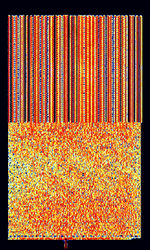High Frequency Data and Voice Link (HFDVL)
HFDVL (or HFD+VL) is an experimental mode developed by research groups from The University of Las Palmas de Gran Canaria and The Polytechnic University of Madrid. This mode is intended for military use in accordance with STANAGNATO Standardization Agreement (STANAG), defines processes, procedures, terms, and conditions for common military or technical procedures or equipment between the member countries of the North Atlantic Treaty Organization (NATO). 5066 parameters.
This mode uses PSKPhase-Shift Keying and OFDMOrthogonal Frequency-Division Multiplexing with a number of different modes seen as experimentation goes on. The OFDMOrthogonal Frequency-Division Multiplexing data portion uses 73 parallel tones. At the beginning of the transmission is an unmodulated tone followed by a brief BPSKBinary Phase-Shift Keying (1 bit per symbol) burst at 2400 BdBaud (unit symbol Bd) is the unit for symbol rate or modulation rate in symbols per second. that may act as a preamble and a declaration of transmission parameters for the receiving modem to be able to demodulate and decode. Right after the BPSKBinary Phase-Shift Keying (1 bit per symbol) burst is the beginning of the OFDMOrthogonal Frequency-Division Multiplexing Data transfer.
This mode supports STANAGNATO Standardization Agreement (STANAG), defines processes, procedures, terms, and conditions for common military or technical procedures or equipment between the member countries of the North Atlantic Treaty Organization (NATO). 5066 ARQAutomatic Repeat reQuestAutomatic Repeat Query procedures, so this signal can be seen with DATA and ACK behaviors in the transmissions. The short bursts are likely Acknowledgements while the longer runs are probably data.
A key feature of this signal is its ability to transmit data and voice at high speed over the HFHigh Frequency (3-30 MHz) band, being very robust against propagation conditions and being able to transmit at speeds of ~8000+ bpsBits per second (bps). The modes that have been used in the OFDMOrthogonal Frequency-Division Multiplexing data segment of the signal includes QPSKQuadrature Phase-Shift Keying (2 bits per symbol) and QAMQuadrature Amplitude Modulation modes. The table below lists some that were used by HFDVL.
Samples[edit]
An extended recording of HFDVL transmissions can be downloaded here.
Frequencies[edit]
Currently as of 2016 there are only two transmitters used to test this mode, operating at 14.8285 MHzMegaHertz (MHz) 10^6 Hz and 14.350 MHzMegaHertz (MHz) 10^6 Hz.
Additional Links[edit]
- i56578 swl Analysis of HFDVL
- A Spanish Modem for Transmitting Data at High Speeds on HF (En Español)
- RadioAficionados HFDVL
- HFDVL Main Page



